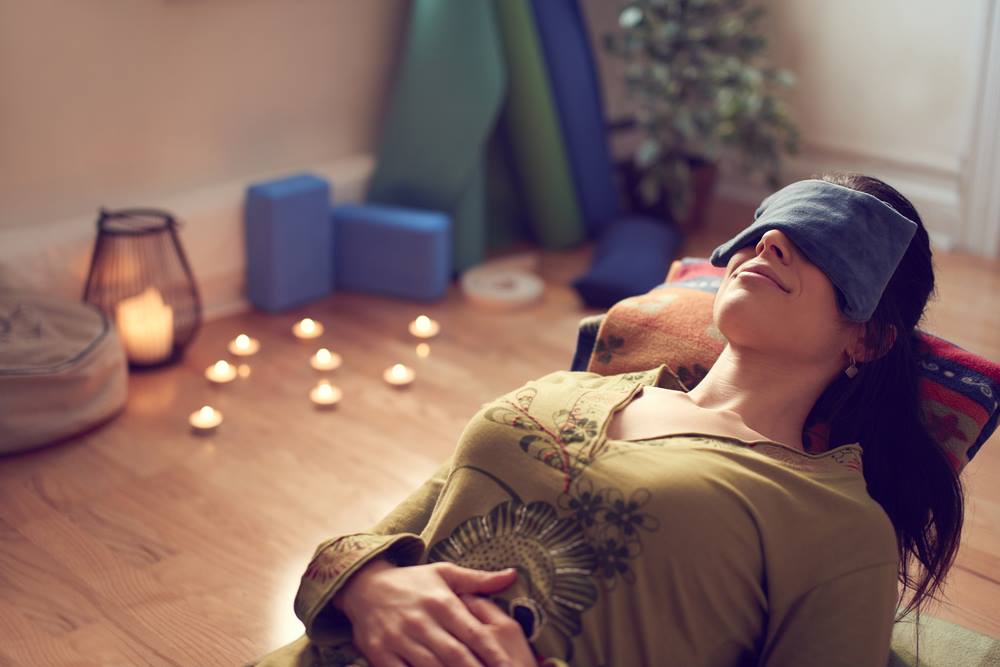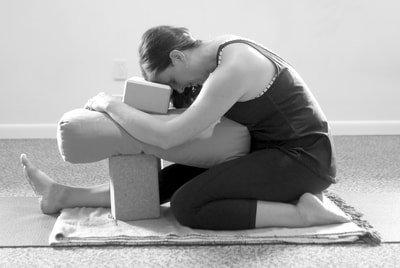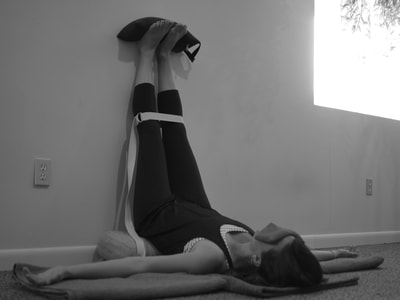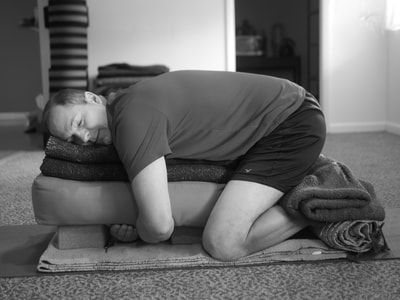|
What is Restorative Yoga? Restorative yoga is a style of yoga accessible to anyone at any time to create balance, quiet and restore our bodies and minds to a state of homeostasis. The system uses props and supports that allow the practitioner to hold poses for a longer period of time without strain, promoting deeper relaxation and creating a space for healing. Restorative yoga has a great therapeutic impact during times of illness, injury, pain, stress and overscheduled lives. Restorative yoga helps to cultivate a healing environment in the body by balancing the nervous systems’ optimal energy flow; restoring us at a physical, physiological, energetic and emotional level. Props may include, but are certainly not limited to, blankets, bolsters, chairs, blocks, straps and eye pillows. What are the benefits of Restorative Yoga?
Restorative Yoga brings balance to a fast paced lifestyle and has an enormous capacity to heal physical and mental symptoms that are stress related, and as we know, many diseases are stress related. The beauty of Restorative Yoga is that there is no muscular contraction involved. We believe we have to “work” to increase flexibility, but often we achieve more opening in parts of the body that we perceive as tight by softening and relaxing than through an active asana practice. During a restorative yoga sequence, you still mildly stretch, but you relax fully in the body with support so that tension can slowly be released. When the body and mind quiet and become soft, we create space to get in touch with our natural qualities of compassion and understanding of others and self. Restorative Yoga and Yin Yoga: Are they the same? On the surface restorative yoga and yin yoga may look very much alike. The two forms have some similarities while remaining quite different in their intentions and outcomes. Both styles will hold poses for a longer duration, yet how these poses are held and the degree to which they are held will vary significantly. Yin Yoga is a style of Yoga wherein the poses are held in a challenging but comfortable space for a period of several minutes. The aim of Yin Yoga is to place an additional stress on the tissues using gravity as a tool for allowing the tissues to release with time. The goal with yin is to work the connective tissue called fascia, thereby opening up the range of motion and working to increase the general level of flexibility. Yin Yoga uses a moderate amount of physical stress in the form of static/active or static/passive stretch techniques without additional supports that would minimize the release into the pose to achieve a desired opening of the myofascial pathways in the body. One might receive some yin style benefit from Restorative Yoga postures as the poses are also held for a longer period of time. In Restorative Yoga, however the goal is relaxation and the props keep the body from being stressed to the same degree that they would otherwise be in a yin style posture. Restorative uses static/passive techniques with support for minimal stretch. The pure intention of restorative is to find relaxation and decrease stress at the physical, emotional, mental and energetic levels. Restorative yoga places the body into "rest and digest" mode by tuning into the parasympathetic side of the nervous system. Excerpt from:
Boundless Bliss: a Guide to Restorative Yoga by Chris Loebsack, Tracy Gross and Jessica Batha Amazon Release Fall 2018 Upcoming Restorative Yoga Advanced Studies with Tracy and Jess September 14th-16th, 2018
0 Comments
Leave a Reply. |
Boundless Yoga Staff & StudentsWe are continuously interested on how our reactions and responses to our personal journeys, albeit travel, adventure, new job, etc. mirror and reflect our social, emotional and spiritual ups and downs. We try every day to apply what we learn about ourselves on the yoga mat to our personal lives. Thank you for tuning in as we share some of those aspects with you. Archives
December 2022
Categories
All
|
- HOME
-
- Monthly Challenge
- Book Club Discussion
- 7/11-8/1 (Thurs) Meditation & Mindful Movement Series
- 7/17 Beach Day Yoga Road Trip: Ocean Groove NJ
- 8/3- 8/28 (Tues): Roll & Release Series
- Sept/Oct: Inversion Immersion
- Sept-Dec: Personal Development Course
- 9/15 Moon Planning Workshop
- Bhakti Flow and Kirtan w/ Ian Froman
- Schedule
-
- 200 Hour Teacher Training
- 300 Hour Teacher Training
- Arm Balance Academy - CE Program
- Inversion Immersion Training Program
- Personal Development- Continuing Studies
- Thai Yoga Training
- The Boundless Breath ~ Pranayama Training Weekend
- The Koshas Demystified - Yoga Philosophy Course
- Rollit & Release it: Yoga and Fascia Continued Studies
- Yin Yoga Basics Course
- Yin Yoga Advanced Course
- Aerial Yoga Teacher Training
- Professional Development Continuing Studies Module
- Boundless Vinyasa Sequencing- Unlock the Power of Combination and Flow
- Aerial Yoga Yin-Restorative Training
- Graduate Directory
- Yoga Online Anytime
- Contact Us
- Blog: Insights from our Staff and Students
- Community Resources
- Studio Rental
- Media and News
- Yoga Podcast: Chats from the Mat w/ Brian M. Davis
- HOME
-
- Monthly Challenge
- Book Club Discussion
- 7/11-8/1 (Thurs) Meditation & Mindful Movement Series
- 7/17 Beach Day Yoga Road Trip: Ocean Groove NJ
- 8/3- 8/28 (Tues): Roll & Release Series
- Sept/Oct: Inversion Immersion
- Sept-Dec: Personal Development Course
- 9/15 Moon Planning Workshop
- Bhakti Flow and Kirtan w/ Ian Froman
- Schedule
-
- 200 Hour Teacher Training
- 300 Hour Teacher Training
- Arm Balance Academy - CE Program
- Inversion Immersion Training Program
- Personal Development- Continuing Studies
- Thai Yoga Training
- The Boundless Breath ~ Pranayama Training Weekend
- The Koshas Demystified - Yoga Philosophy Course
- Rollit & Release it: Yoga and Fascia Continued Studies
- Yin Yoga Basics Course
- Yin Yoga Advanced Course
- Aerial Yoga Teacher Training
- Professional Development Continuing Studies Module
- Boundless Vinyasa Sequencing- Unlock the Power of Combination and Flow
- Aerial Yoga Yin-Restorative Training
- Graduate Directory
- Yoga Online Anytime
- Contact Us
- Blog: Insights from our Staff and Students
- Community Resources
- Studio Rental
- Media and News
- Yoga Podcast: Chats from the Mat w/ Brian M. Davis
Get more updates and fun yoga information on our Facebook page!





 RSS Feed
RSS Feed